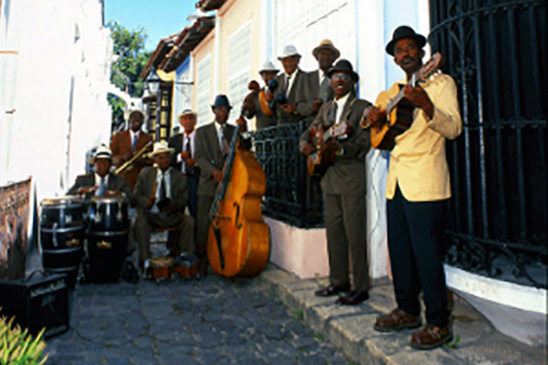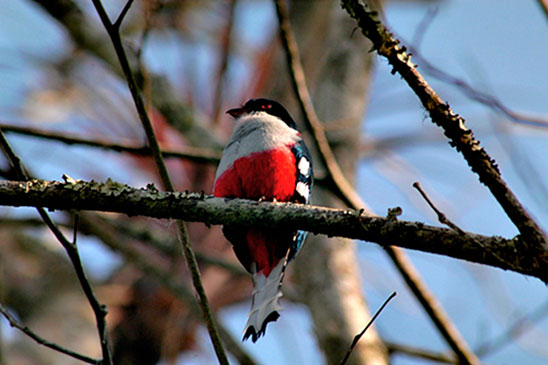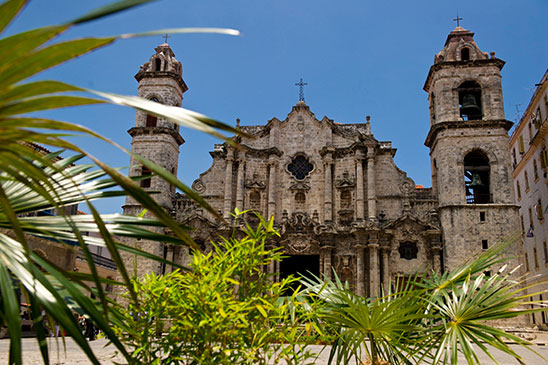Culture
The culture of Cuba enjoys international reputation as one of the richest in the world. It has passed through four historically important generations, accounting for all its richness, diversity and significance.
Cuba has produced major international figures in literature and fine arts, film, ballet, modern dance and theater. The country is also renowned for its original rhythms, such as danzón, son, bolero, mambo, cha-cha-chá and many more.
Cuba’s prestigious cultural events attract international celebrities in dance, music, theater and other forms of art. Some of these gatherings include Casa de las Américas Literary Contest, Havana International Ballet Festival, the Festival of
New Latin American Cinema and the International Jazz Festival.
Cuba also boasts a really rich literature that has given rise to many important writers and poets. Thus, the culture of Cuba enlightens tourists about the social heritage of the country.

Traditional cuban music band
Geography
Location: Northwest Caribbean Time GMT – 5 (GMT – 4 from last Sunday in March to last Sunday in October) Area: 109,886.19 km2 (44,218 sq. miles) Population: 11,240,841 million Population Density: 102 per sq. km. Capital: Havana Population: 2.2 millionThe Republic of Cuba is an archipelago in the Caribbean Sea, near the entrance to the Gulf of Mexico. The country consists of the main island, Cuba, the largest in the Caribbean, the Isle of Youth (Isla de la Juventud), Cayo Largo and some 4,195 islets and keys. Cuba is divided into 15 provinces, 169 municipalities and the Special Municipality of the Isle of Youth. From west to east, the provinces are Pinar del Río, Artemisa, Mayabeque, Havana, Matanzas, Cienfuegos, Villa Clara, Sancti Spíritus, Ciego de Ávila, Camagüey, Las Tunas, Holguín, Granma, Santiago de Cuba and Guantánamo.
Cuba is a long, narrow island (1,200 kilometers from Cabo de San Antonio, the westernmost tip, to Punta de Maisí, at the easternmost end). At its widest point, it measures 191 kilometers; with only 31 kilometers at its narrowest. The Cuban landscape is dominated by plains, with four major mountain ranges: the Guaniguanico mountains, in the west; the Guamuhaya mountains in the central part; the Sagua-Baracoa range and the Sierra Maestra mountains in the east. The latter contains the country´s highest peak: Turquino, rising 1,974 meters. The landscape is diverse, ranging from semi-deserts to tropical rain forests. The country has a large biodiversity and well-preserved ecosystems.
Economy and Goverment
Up until the demise of the Soviet Union, over 85% of Cuba’s trade was with the eastern bloc. The collapse of the Union has caused Cuba to look for other trading partners and rethink its economic planning. This has brought about many joint ventures with foreign countries, such as Canada, Spain, Germany, South America and the UK. Cuba’s main income earners are tourism, sugarcane, nickel, construction materials, oil, medical drugs, as well as coffee, tobacco and citrus fruits.The Republic of Cuba is one of the last strongholds of socialism, with people exercising their power through the Municipal, Provincial and National Assemblies. Raúl Castro Ruz is the President of the Council of Ministers and of the Council of State, as well as the First Secretary of the Communist Party of Cuba.
Language and Education
The official language is Spanish, although many Cubans have studied English, French, German or Russian.Education is provided free of charge at all levels and is compulsory through ninth grade. In 1961, the country eradicated illiteracy through the National Literacy Campaign. Specialized polytechnics, universities and other higher education centers exist in all the provinces.
Health
Cuba’s primary healthcare system is considered unique in Latin America, as medical services are provided free of charge to all Cubans. The infant mortality rate is 4.6 per 1,000 live births (end of 2012), while life expectancy stands at 75 years. Cuba is among six countries in the world that produce interferon. Its vaccines against meningitis B and C and hepatitis B are unique in the world. These achievements are made possible thanks to the 211 scientific research institutes and production facilities.
Ethnic Background
Most Cubans are of mixed race. Criollos (over 65%) are from European descent, Mulatos (25%) are a fusion of European and African descent, Morenos (10%) are of pure African ancestry; and finally, there is a small percentage of Spanish and Chinese.
Flora and Fauna
More than 300 protected areas in the country occupy some 22% of the island. Six of these have been declared World Biosphere Reserves by UNESCO: Guanahacabibes Peninsula, Sierra del Rosario and Ciénaga de Zapata, in the west; Buenavista in central Cuba and Baconao Park and Cuchillas del Toa in the east. More than half of the island’s diverse flora and fauna are indigenous.As you would expect in tropical climate, Cuba has many species of plants. Nearly 7,000 of them can be found in our territory, of which some 50% are native to the island. The flora is varied, with orchids ranking high. Orchids have outstanding colors, flawless shapes and account for more than 300 species. The national flower of Cuba is the white ginger lily or mariposa blanca (Hedychium coronarium), a tiny orchid with white petals. The national tree is the royal palm tree or palma real (Roystonea), reaching heights of 15 to 23 m. (50-75 ft.). Both can be found all over the island.
The forests and hilly areas of Cuba are home to diverse species of wildlife, some of the most important being:
- Cuban trogon or tocororo (Priotelus temnurus)
- Jutía (a rodent), also known as banana rat (Capromyidae family)
- Snakes like the boa constrictor or majá de Santamaría
- The national tree is the royal palm tree or palma real (Roystonea)

Cuban trogon or tocororo (Priotelus temnurus)
The Cuban high-crested toad Cuba’s flora and fauna form an exuberant and striking picture of the landscapes of the island. It can be said that its wildlife is one of the primary attractions of this Caribbean haven.
The mountainous areas are covered by tropical forest, but Cuba is essentially palm-studded grassland. Pines like those in the southeastern US grow on the slopes of Sierra de los Órganos (a low mountain range) and on Isla de la Juventud (Isle of Youth), off the mainland. The lower coastal areas, especially in the south, have mangrove swamps. There is a small area around Guantánamo Bay where desert plants grow.
Only small animals inhabit Cuba. These include tropical bats, rodents, birds and many species of reptiles and insects. No land animal is harmful in Cuba. The largest animals you can find are deer, wild boar and freshwater crocodiles. It is bird life what makes Cuba so special, with approximately 300 native species. Of course, the most famous bird on the island is the bee hummingbird or zunzuncito/pájaro mosca (Mellisuga helenae), the smallest in the world. Cuba's national bird, however, is the Cuban trogon or tocororo (Priotelus temnurus), whose natural habitats are dry forests, moist forests and heavily degraded former forests.
History
Cuba was first discovered by Christopher Columbus on 27 October 1492. For a man who had seen countless tropical islands, he was extremely impressed with Cuba, saying “this is the most beautiful land human eyes have ever seen”. After its discovery, the island was quickly colonized by the Spaniards, at the expense of the local aboriginal population. By 1600, Spain had founded the first seven settlements: Baracoa, Bayamo, Trinidad, Sancti Spíritus, Puerto Príncipe and San Cristóbal de la Habana.By the 19th century, a sentiment of national belonging had started to emerge in the hearts of the Cuban population; thus, a movement arose to gain independence from Europe. The First War of Independence began on 10 October 1868, led by Carlos Manuel de Céspedes, known as “the Father of the Homeland”. After ten years of fighting, the struggle ended in defeat.
The second attempt started on 24 February 1895, led this time by José Martí, considered the country’s National Hero. He founded the Cuban Revolutionary Party in early 1892; and by 1898, victory was within sight. However, the US Government intervened and declared war on Spain, but prevented Cuba from attaining power even after their defeat.
The Republic was declared on 20 May 1902, followed by a long period of economic and political dominance by the US that lasted through 1 January 1959, when the Revolution finally triumphed. This was achieved after several years of fighting in the Sierra Maestra mountain range near Santiago, assisted by an underground struggle in the cities that finally toppled the Batista regime on New Year’s Eve.
Religion
Religion does not generally play a large part in a Cuban’s daily life. Years ago, before the Revolution, people used to practice Catholicism. Churches were scattered throughout the country, some of which were very beautiful and ornate. Nowadays, it is a different story, with only 80,000 devout Catholics on the island.>With ever-growing numbers of people coming from different locations and following different beliefs, Cuba has become a country with a large array of religions. You will find Baptists and Methodists congregating on Sundays; and Havana boasts a mosque, a synagogue and a Quaker meeting house. Although Christianity has a small following, animism ancestor worship from Africa has strong numbers and not just among black Cubans.
The Africans absorbed certain Catholic ways into their own religions and were, therefore, accepted in Cuba. There are three main forms of African-based beliefs still around today. The first is Santería, or saint worship. There are hundreds of such saints linked to Catholic saints, with both Christian and African names. Saints’ Day celebrations are colorful affairs, with families decorating little shrines in their homes and inviting friends to share rum and an assortment of cakes. Palo Monte is a highly secret religion, where black magic plays a part. The select few gather in a masonic-type lodge and even have their own special handshake. Abacuá is open only to men and has a small following. The religion originates in Nigeria and its members are called karabalís.

Church of El Cobre
Food and Drinks
Cuban cuisine is influenced by Spanish, African and Chinese methods of cooking. The Spanish introduced root vegetables, rice and beef and some of their own regional dishes. West Africans brought in yams and tropical vegetables, while the Chinese taught the locals how to use fresh fruit and vegetables to whip up unusual meals."Criolla" cooking (comida Criolla) is very popular throughout the country, although it can be difficult at times to come by all of the required ingredients. Such cooking style uses pork steaks with yams, rice and beans (either kidney or black), flavored with a variety of spices.
The national dish is ajiaco, a stew of assorted root vegetables cooked with pork, poultry or beef. Other typical dishes are lechón (roast pork); fried green plantains (tachinos, chatinos or tostones); black beans, congrí (rice and red beans), moros y cristianos (rice and black beans) and picadillo a la habanera (ground beef in tomato sauce), roast chicken and tamales, among others. The Cuban sweet tooth ensures that each meal will include luscious desserts.
A very typical Cuban meal would be a salad (lettuce, tomato, beetroot and sliced cold carrot) or a plate of fruit (sliced orange, grapefruit and mango when in season) for starters. This would be followed by large plates placed in the middle of the table, so that everyone can help themselves: usually, black beans and rice, fried bananas and the center plate of meat. This would most likely be pork, chicken or steak, but always cooked with plenty of garlic.
Vegetarians are no so well catered for except in hotel buffets, where there is always a good assortment. If waiters or chefs know the foods you can or cannot eat, they may even whip up a special plate just for you. As a nation surrounded by seawater, there is a wide selection of fish and shellfish available in most restaurants. The buzzword is ‘pescado’ (fish); however, it refers to whatever has been caught that day and you will rarely see the actual name of the fish. Langostas (lobsters) and camarones (shrimps) are common in the waters around us, but are still quite a pricey dish, although nowhere near as expensive as back home.
You will discover during your holiday that Cubans produce a lot of their own drinks. The local beers are very good and the main brands are Cristal, Mayabe and Bucanero. They also produce specialty cacao, orange and coffee liqueurs. Tropicola and TuKola are local brands of Coke, widely used in Cuba Libre cocktails. When out on tour, you may try some fresh sugarcane juice or coconut milk. Cubans drink coffee out of tiny cups and like it sweet, strong and not too hot. The quality of Cuban rum is recognized internationally and comes in four distillations: refined, white, gold and aged. Gold and aged rums are better for drinking straight, while white rum (Carta Blanca or Carta Plata) is best for cocktails. Several of the world’s most famous rum-based cocktails are Cuban, and are served in most bars around the globe. Such drinks include Cuba Libre, Mojito, Daiquirí, Cubanito and Saoco.

Classic Daiquiri in Floridita Bar Restaurant. There are some 69 cocktails that can be made out of Havana Club Rum.



